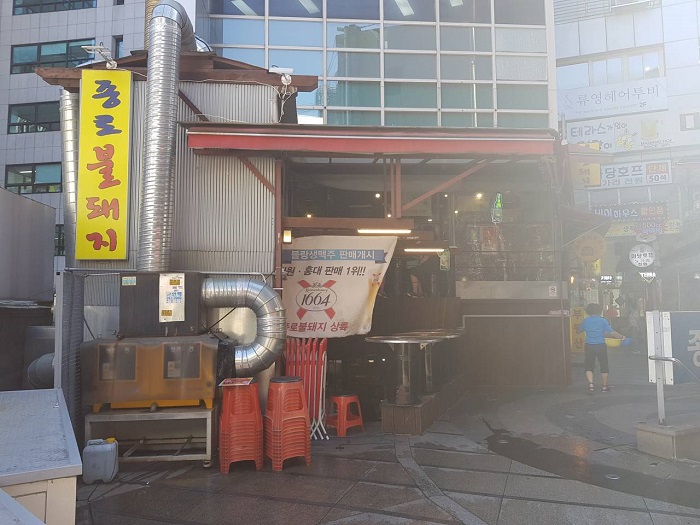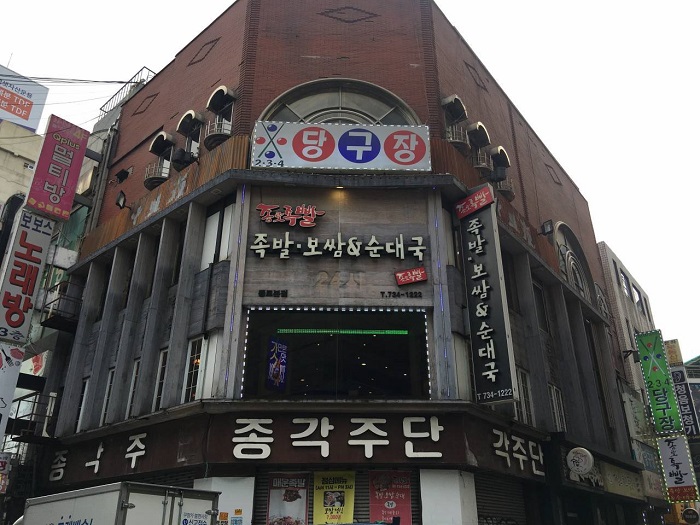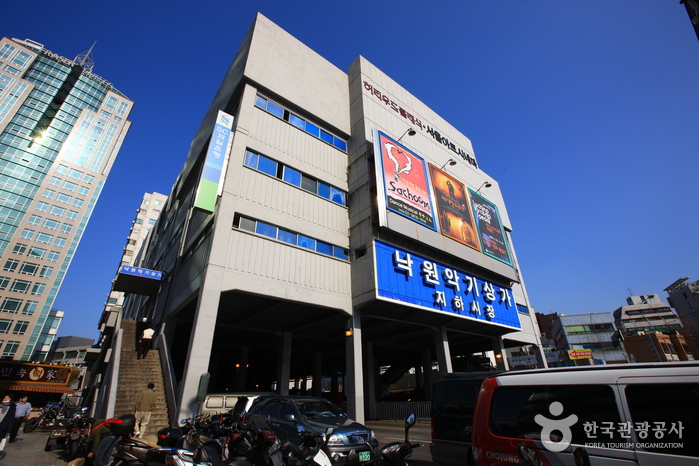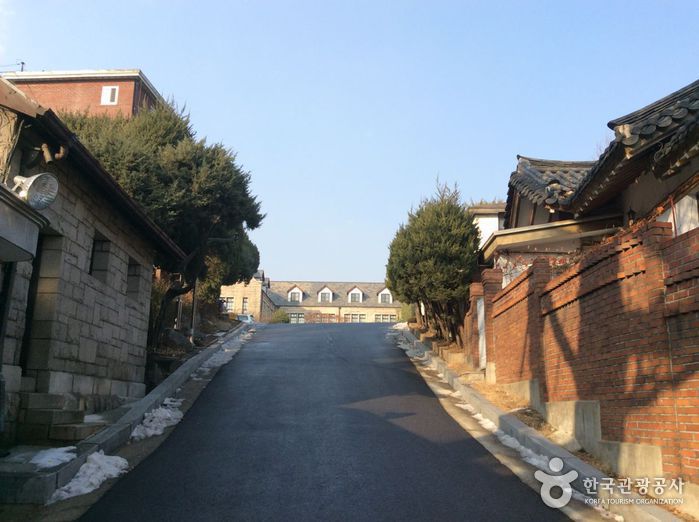Jongno Buldwaeji(종로불돼지)
1.5Km 2020-11-19
67, Cheonggyecheon-ro, Jongno-gu, Seoul
+82-2-734-1190
A place that sells pork pre-grilled on briquette fire. The best menu at this restaurant is skin-on pork belly. This Korean dishes restaurant is located in Jongno-gu, Seoul.
Jongnojokppal (종로족빨)
1.5Km 2021-03-22
22, Ujeongguk-ro, 2-gil, Jongno-gu, Seoul
+82-2-734-1222
A famous place for group dinners among workers in Jongno. This Korean dishes restaurant is located in Jongno-gu, Seoul. The most famous menu is braised pigs' feet.
Hotel Crown Insadong (호텔 크라운-인사동)
1.6Km 2021-02-10
9, Samil-daero 30-gil, Jongno-gu, Seoul
+82-2-3676-8000
Hotel Crown is a premier hotel that was renovated in May 2002. The hotel is in close proximity to Jongno and Insa-dong, making it a convenient place to stay for tourists.
Moonguesthouse [Korea Quality] / 문게스트하우스 [한국관광 품질인증]
1.6Km 2020-09-09
31-18, Samil-daero 32-gil, Jongno-gu, Seoul
+82-2-745-8008, +82-10-8704-9981
The Moon Guesthouse is situated near a number of interesting tourist destinations including Unhyeongung Palace (3min on foot), Bukchon Hanok Village (5min on foot), Changdeokgung Palace (5min on foot), and Changgyeonggung Palace (10min on foot). The guesthouse was named ‘moon’ (‘door’ in English) because it has many 176 doors and windows. Upon entering by the gate, visitors will see a ‘ㄷ’-shaped hanok building in the courtyard, in which a wooden bedstead and a table are placed. On the opposite of the hanok building there is a wall roofed with tiles engraved with Korean patterns such as deer, pine, turtle, etc. Flowers in the flowerbed lined up along the wall are in bloom and the bonsai are also well-kept in the house. Renovated and opened as a guesthouse in September 2011, Moon Guesthouse consists of a bonchae (main building) and a byeolchae (detached house). The rooms are decorated with red clay and hanji (traditional Korean paper handmade from mulberry trees), and have under-the-floor heating (ondol). Each room is equipped with an air-conditioner, and has a 40cm-thick layer of red clay over the ceiling for insulation, making the rooms cool in summer and warm in winter. The house has seven individual guestrooms and five modern bathrooms, but the entire building (bonchae or byeolchae) can be rented, too. In particular, the unhyeondang of the bonchae is very popular as it can be converted into one large space for special events, group workshops, etc. simply by opening all the sliding doors (Bunhapmun – Goryeo construction style). This room, which is decorated with a flower-patterned windscreen, a landscape painting, and calligraphy, has been used as a shooting location for various TV programs including KBS2’s TV reality program Man’s Qualification and its variety show The Human Condition. The guestrooms are also equipped with traditional furniture including a cabinet inlaid with mother-of-pearl. The guesthouse also provides a variety of experience programs from 11am to 3pm, including tea ceremony, wearing Hanbok (traditional Korean clothes), making kimchi and gochujang (red chili paste), playing a traditional musical instrument, making a rubbing of a stone inscription, calligraphy, drawing orchids on a fan, and so on. The house has about seventy hanbok and other clothing accessories, as well as a royal costume. Its calligraphy and drawing orchid programs are run directly by the owner, who used to work as a classical Chinese teacher at a high school.
Magasins d'instruements Nakwon Sangga 낙원 악기상가
1.6Km 2018-07-03
Seoul, Jongno-gu, Samildae-ro 428
02-743-6131
Les magasins d'instruments 'Nakwon Sangga', situés près du quartier traditionnel d'Insadong, ont vu le jour dans les années 1970. Il s'agit d'une grande surface spécialisée dans la vente d'instruments, de partitions, d'équipements audio etc où les clients peuvent recevoir les conseils d'expert. Il s'agit d'une des plus grandes surfaces du genre dans le monde. On peut y trouver de nombreux magasins de guitares, toutes sortes d'instruments à cordes, des batteries, des amplis, des effets etc. La surface propose aussi des instruments d'occasion et des services de réparation.
Festival de l’art et de la culture coréens d’Insa (인사전통문화축제)
1.6Km 2021-03-26
Insa-dong, Jongno-gu, Seoul-si
- Ligne Info Tourisme : +82-2-1330 (coréen, anglais, japonais, chinois) - Pour obtenir plus d'info : +82-2-731-1161 (coréen)
La rue d’Insa-dong, classée district culturel en avril 2002, est un haut lieu de tradition et de culture avec ses nombreuses galleries d’art, antiquaires et boutiques de livres anciens. Le festival de l’art et de la culture coréens d’Insa-dong est de plus en plus apprécié pour ses manifestations mettant en valeur les particularités d’Insa-dong. Le festival de l’art et de la culture coréens de Insa, sponsorisé par la Société pour la préservation de la culture et des traditions de Insa, fête cette année ses 20 ans.
Programme des manifestations :
Depuis ses débuts en 1987, les attractions et spectacles du festival de l’art et de la culture coréens de Insa a largement contribué à faire connaître Insa-dong comme un lieu incontournable de la culture et de la tradition. Le festival perpétue l’héritage prospère d’Insa-dong et permet aux visiteurs de participer à diverses activités. Deux festivals permettent de fignoler l’image d’Insa-dong comme rue des galeries d’art : Le festival des antiquités d’art expose des céramiques, des peintures anciennes rares, des objets populaires en bois ; et les merveilles de l’art contemporain sont mises en scène lors du festival de l’art moderne. .
De nombreuses autres manifestations passionnantes apportent au visiteur une bouffée de la Corée de jadis : la seconde présentation d’un mariage coréen traditionnel, l’ancienne parade du chef de la police appelée Pododaejang, un concert de Gayageum pour chanter en choeur, du Samullori, la danse pour la paix Taepyeongmu, la danse des Gisaengs Gyobangmu, un concert de chants folkloriques, etc. .
Durant le festival, les visiteurs peuvent s’initier à tous les aspects de la culture coréenne : des ateliers permettent de découvrir la céramique et la fabrication d’objets à partir de paille, de tracer au pinceau des préceptes familiaux, de peindre des portraits de famille, et de piler la farine de riz selon la méthode traditionnelle. Mais c’est la braderie surprise d’antiquités qui remporte le plus grand succès. On peut y acheter des antiquités pour seulement 10 000 wons environ. C’est une opportunité exceptionnelle pour acquérir de très beaux objets anciens à un prix intéressant, et c’est possible uniquement durant le festival Insa.
A la une du festival : On trouve pas moins de 362 biens culturels aux alentours d’Insa-donc, parmi lesquels des anciens palais royaux, des sanctuaires ancestraux, des autels dédiés aux divinités d’Etat, le temple bouddhiste de l’ordre de Jogye, le parc de Tapgol, le pavillon de la cloche de Bosingak et la porte de Heunginjimun, aussi les visiteurs peuvent découvrir des hauts lieux de l’histoire coréenne tout en profitant du festival.
Insa-dong est également appréciée des touristes pour ses multiples spectacles, distractions et restaurants réputés. Ne manquez pas non plus à proximité la rue de la jeunesse à Gwancheol-dong, le centre commercial des instruments de musique à Nagwon-dong et la rue des restaurants de Haejangguk (une soupe souveraine contre la gueule de bois) à Cheongjin-dong.
Lycée Jungang (bâtiment principal) (중앙고등학교본관)
1.6Km 2019-07-22
164, Changdeokgung-gil, Jongno-gu, Seoul-si
+82-2-742-1321
Le lycée Jungang, situé à Jong-ro (près de Samcheongdong-gil), a été construit pour éduquer le peuple au coeur de la crise nationale qui sévissait au début du XXème siècle. Le bâtiment principal de l’école a été construit en 1937 après qu’un incendie ait détruit la bâtisse de deux étages d’origine en 1934. L’architecture gothique moderne de ce bâtiment est particulièrement significative pour les Coréens, car celui-ci a été conçu par un architecte coréen durant l’époque de la colonisation japonaise. Park Dong Jin, qui a conçu ce bâtiment, est l’un des premiers architectes coréens modernes, et a dessiné les plans du bâtiment principal et de la bibliothèque de l’université Korea, ainsi que l’immeuble du journal Chosunilbo. Le lycée Jungang a été désigné site historique n° 281. De nombreux leaders de la nation ont été éduqués derrière les murs de ce bâtiment gothique durant la période sombre où la Corée a tenté d’échapper au joug colonial.
Le bâtiment principal, situé en face de la porte principal, est une bâtisse en granit de deux étages en forme de H, conçu dans le style gothique, avec une tour de quatre étages au centre.
Bukchonmaru hanok guesthouse [Korea Quality] / 북촌마루한옥게스트하우스 [한국관광 품질인증]
1.6Km 2020-09-10
152, Changdeokgung-gil, Jongno-gu, Seoul
+82-10-3253-8751
Bukchonmaru Hanok Guesthouse is located between “Bukchon Views 2 and 3” on a hill in Bukchon Village in Seoul. This two-storied hanbok building with a terrace, which is rarely found among other hanok structures in the area, offers a splendid view of Seoul. In particular, the summit of a hill next to the main gate of Choong Ang High School where the guesthouse is situated is known as the filming location for the famous Korean TV series Winter Sonata (2002). When you open the main gate and go up to the first floor, a small yard is seen with a group of jars on one side. After entering the sliding door through the yard, there is daecheong maru (main floored room) that features the doors opening in all directions and a high ceiling with rafters, making the space open and cozy. The hanok building consists of two floors – the ground floor is equipped with special furniture, a jar table and a log chair made by the owner, and on the first floor are guestrooms comprised of one large room and two small rooms. The neat and clean rooms are designed in a simple way and have lovely bedding with the pattern of five cardinal colors. Its staff members can speak English and Chinese to communicate with guests from other countries. Every morning, guests engage in animated conversation while enjoying a Korean home-style breakfast prepared by the owner in a friendly atmosphere. After having breakfast, if guests want, they can try on traditional Korean clothes (hanbok) and take photographs inside and around the guesthouse to create interesting memories. The guesthouse also provides a hanbok rental service (KRW 30,000 for a day) and tourists wearing traditional Korean clothes can enter both Changdeokgung Palace and Gyeongbokgung Palace, which can be reached on foot within 10 to 15 minutes, free of charge. Moreover, guests can enjoy an open view of the area including Gahoe-dong, Gye-dong and even the lights of the Namsan Seoul Tower at night from the roof top.
Pierre Gagnaire à Seoul (피에르 가니에르)
1.6Km 2019-12-24
30, Eulji-ro, Jung-gu, Seoul
+82-2-317-7181
Internationally renowned as a Michelin three-star chef, Pierre Gagnaire opened his Seoul restaurant, Pierre Gagnaire à Seoul, on October 1, 2008. This is his fourth restaurant following those restaurants in Paris, Tokyo, and Hong Kong. In fact, he was once ranked first among the 100 top chefs in the world. It offers French cuisine featuring innovative and diverse preparation methods with an added artistic touch.
Momoyama (모모야마)
1.6Km 2019-12-17
30, Eulji-ro, Jung-gu, Seoul
+82-2-317-7031
Momoyama is a Japanese restaurant that serves high quality sushi and kaiseki (tasting menu of small, intricate dishes). In addition, the restaurant features a collection of 80 different types of sake along with a sake somelier. The restaurant is also equipped with several private rooms of varying sizes.



![Moonguesthouse [Korea Quality] / 문게스트하우스 [한국관광 품질인증]](http://tong.visitkorea.or.kr/cms/resource/09/2577509_image2_1.jpg)


![Bukchonmaru hanok guesthouse [Korea Quality] / 북촌마루한옥게스트하우스 [한국관광 품질인증]](http://tong.visitkorea.or.kr/cms/resource/32/2574032_image2_1.jpg)
 Français
Français
 한국어
한국어 English
English 日本語
日本語 中文(简体)
中文(简体) Deutsch
Deutsch Español
Español Русский
Русский